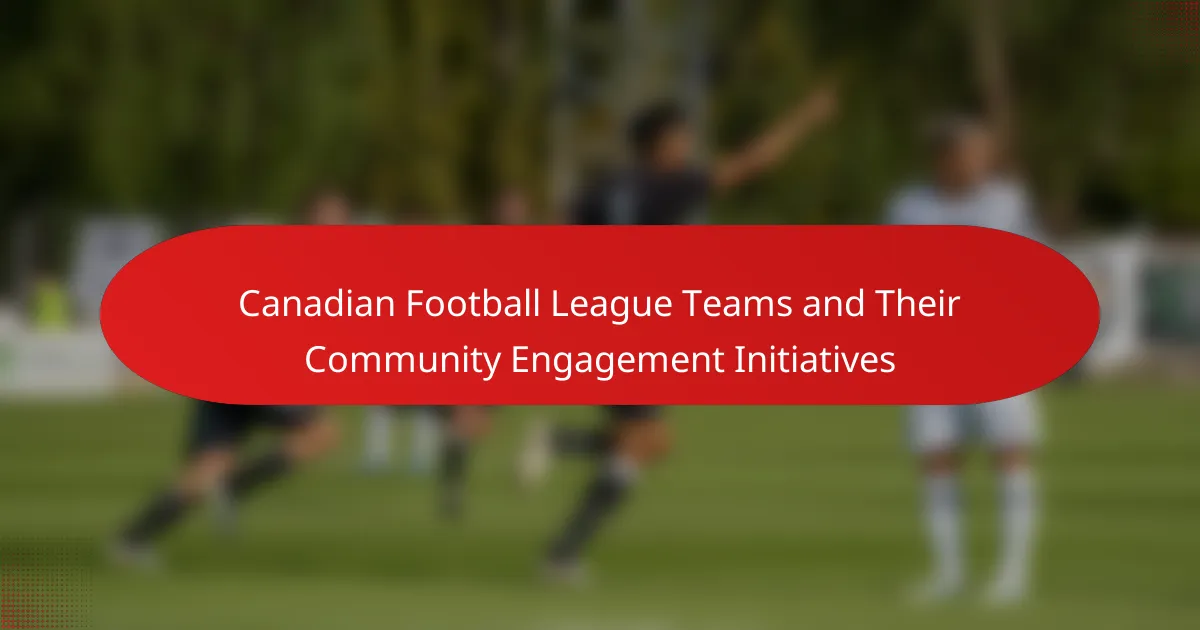Canadian Football League teams play a vital role in their communities through various engagement initiatives. This article explores youth programs, charitable events, and community outreach activities. It highlights specific team efforts, such as the Toronto Argonauts’ mentorship programs and the BC Lions’ support for mental health. Additionally, it addresses the challenges teams face and best practices for effective community involvement.
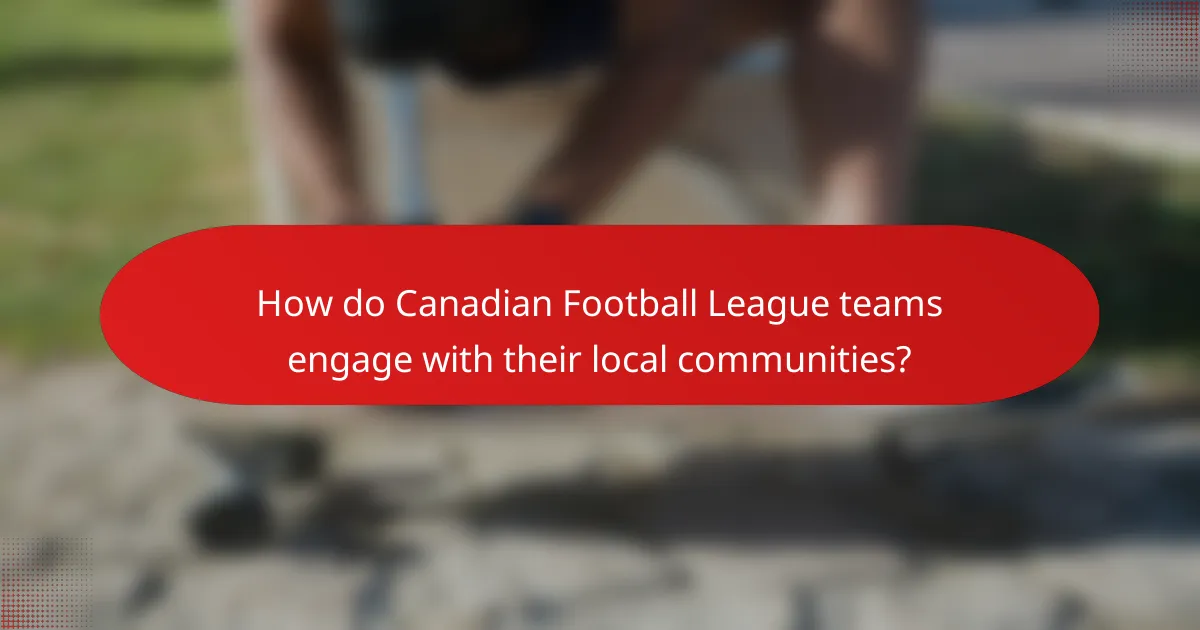
How do Canadian Football League teams engage with their local communities?
Canadian Football League teams actively engage with their local communities through various initiatives. These efforts include youth programs, charitable events, and community outreach activities designed to foster connections and support local causes.
Many teams host youth football camps, providing coaching and mentorship to aspiring young athletes. For instance, the Toronto Argonauts run programs that teach essential skills while promoting teamwork and discipline.
Additionally, teams participate in charitable events, partnering with local organizations to raise funds and awareness for important issues. The BC Lions, for example, support mental health initiatives by collaborating with local charities.
Community outreach activities, such as school visits and public appearances, further strengthen relationships between teams and their fans. These initiatives not only enhance the teams’ presence but also contribute positively to the communities they represent.
What are the common community initiatives undertaken by CFL teams?
Canadian Football League teams engage in various community initiatives to foster local connections and support social causes. Common initiatives include youth mentorship programs, health awareness campaigns, and supporting local charities. Teams often organize events like community clean-ups and food drives, promoting volunteerism among players and fans. These efforts aim to enhance community well-being and strengthen the bond between teams and their cities.
Which organizations partner with CFL teams for community engagement?
Canadian Football League teams partner with various organizations for community engagement, including local charities, schools, and non-profits. These collaborations enhance outreach and support initiatives like youth programs, health awareness, and social inclusion. For example, the Toronto Argonauts work with the United Way, while the BC Lions engage with local schools for educational programs. These partnerships foster community spirit and provide valuable resources to underserved populations.
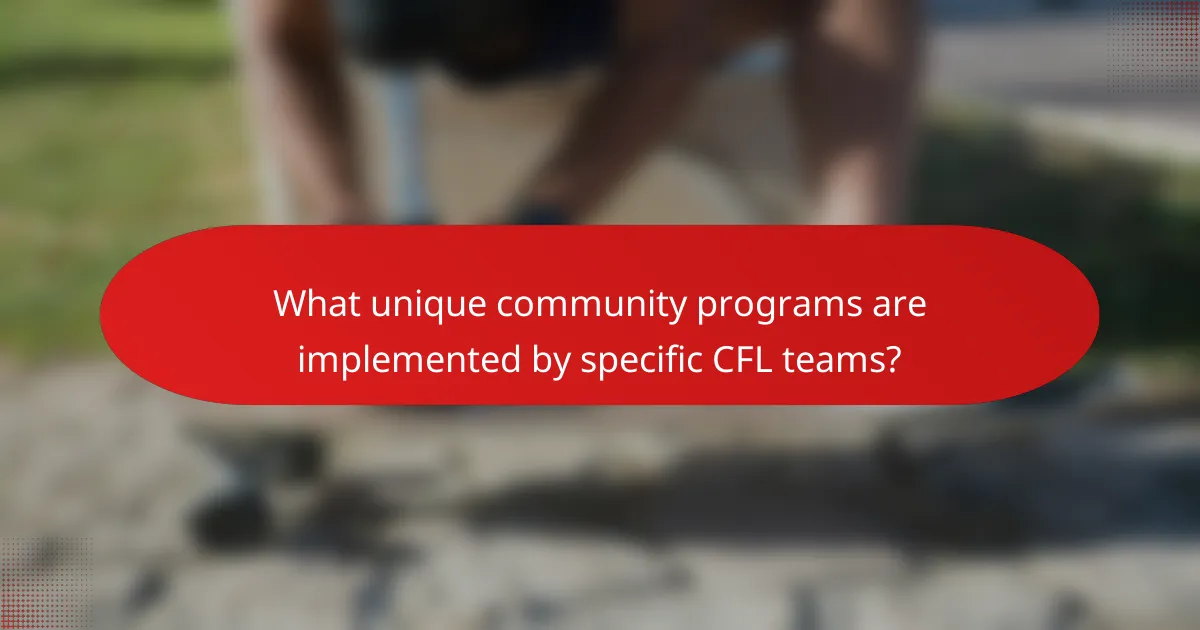
What unique community programs are implemented by specific CFL teams?
The unique community programs implemented by specific CFL teams include various initiatives that enhance local engagement. The Toronto Argonauts focus on youth mentorship through their “Argos in the Community” program, while the BC Lions host “Community Football Days” to promote sports participation. The Calgary Stampeders emphasize health and wellness with their “Stampeders School Program,” which educates students on fitness. The Winnipeg Blue Bombers run “Project 11,” supporting mental health awareness among youth. The Hamilton Tiger-Cats engage fans with their “Ti-Cats Foundation,” funding local charities. Lastly, the Saskatchewan Roughriders promote Indigenous culture through their “Rider Nation Reconciliation” initiative.
How does the Toronto Argonauts’ community outreach differ from other teams?
The Toronto Argonauts’ community outreach emphasizes inclusivity and educational programs, setting them apart from other Canadian Football League teams. Their initiatives focus on youth engagement, promoting physical fitness, and supporting local schools. The Argonauts host events like “Argos in the Community,” which fosters relationships with diverse groups. They prioritize long-term partnerships with organizations, enhancing their impact. This unique approach cultivates a strong community connection, distinguishing them in the league.
What innovative initiatives have the Saskatchewan Roughriders launched in their community?
The Saskatchewan Roughriders have launched several innovative initiatives focused on community engagement. They prioritize youth programs, environmental sustainability, and health awareness.
One significant initiative is the “Rider Nation Community Fund,” which supports local charities and projects. The team also engages in educational programs that promote physical fitness and teamwork among youth. Additionally, the Roughriders have committed to sustainability efforts, such as reducing waste at games and promoting recycling.
These initiatives highlight the Roughriders’ dedication to enhancing community well-being while fostering a strong connection with fans.
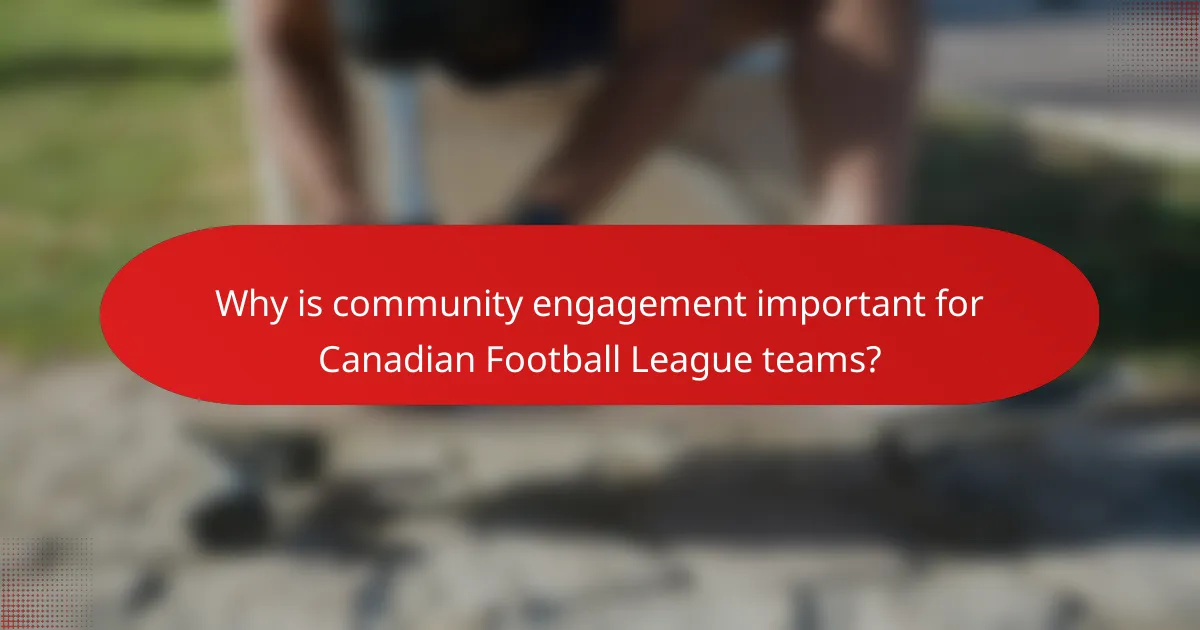
Why is community engagement important for Canadian Football League teams?
Community engagement is crucial for Canadian Football League teams as it fosters strong local connections and enhances team loyalty. Engaging with communities builds a supportive fan base and promotes positive social impact. Initiatives such as youth programs, charity events, and local partnerships increase visibility and strengthen relationships. These efforts not only boost attendance but also create a sense of belonging among fans, making teams integral to their communities.
How does community engagement impact team branding and fan loyalty?
Community engagement significantly enhances team branding and fosters fan loyalty in the Canadian Football League. By actively participating in local initiatives, teams build strong connections with their communities, creating a sense of belonging and shared identity.
Teams like the Toronto Argonauts and Calgary Stampeders engage in outreach programs, charity events, and youth sports initiatives, which strengthen their brand image. This involvement not only boosts visibility but also cultivates emotional ties with fans, encouraging loyalty.
Research indicates that teams with robust community engagement see higher attendance and merchandise sales. The unique attribute of community-driven branding differentiates these teams in a competitive sports landscape, making them more relatable and appealing to fans.
As a result, community engagement acts as a powerful tool for Canadian Football League teams, transforming casual supporters into dedicated fans.
What role does community engagement play in youth development programs?
Community engagement is vital for youth development programs as it fosters personal growth and social responsibility. Canadian Football League teams actively participate in their communities, promoting initiatives that empower youth. These programs often include mentorship, sports clinics, and educational workshops, which provide valuable life skills and promote teamwork. For instance, the Toronto Argonauts run programs that focus on leadership and community service, helping youth develop a sense of belonging. Engaging with local communities enhances the impact of youth development efforts, creating lasting relationships between teams and the youth they support.
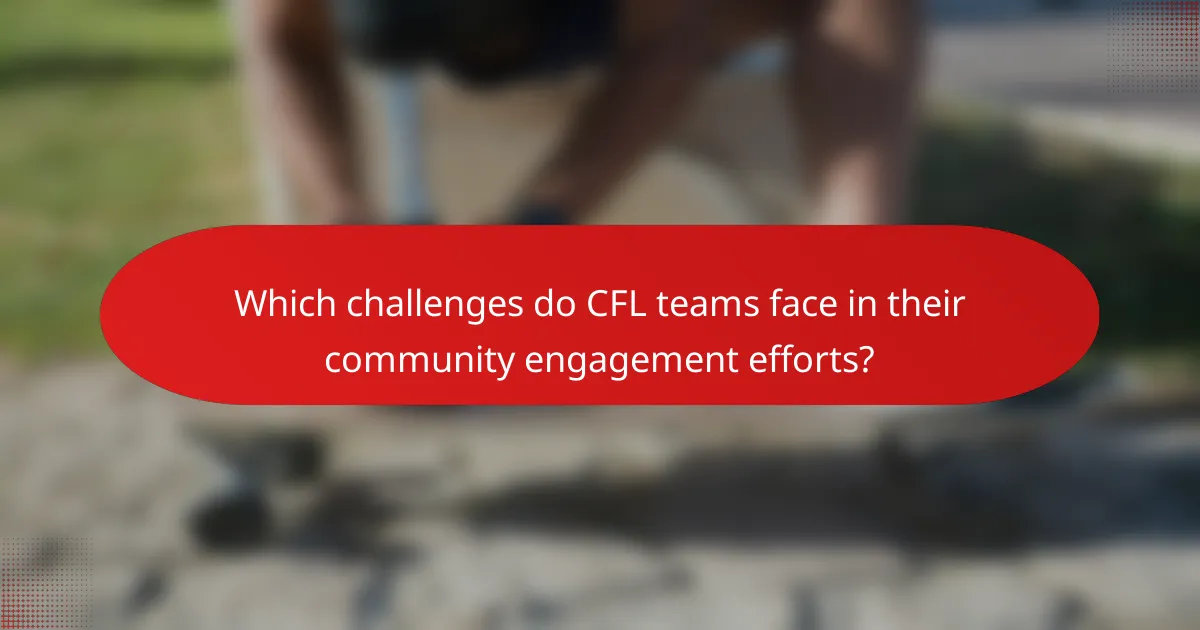
Which challenges do CFL teams face in their community engagement efforts?
CFL teams face challenges like limited resources, competition with other sports, and varying community interests. These factors hinder effective engagement. Teams must adapt their strategies to connect with diverse audiences and foster local support. Additionally, maintaining consistent communication and addressing community concerns are essential for building lasting relationships.
How do CFL teams address funding limitations for community initiatives?
CFL teams address funding limitations for community initiatives through strategic partnerships, sponsorships, and community fundraising events. These approaches enhance financial resources while fostering local engagement. Teams often collaborate with local businesses to secure sponsorships, which provide essential funding for various programs. Additionally, they organize community events that not only raise funds but also strengthen relationships with fans. As a result, these initiatives contribute to the overall growth and sustainability of community engagement efforts within the league.
What are the barriers to participation in community programs for fans?
Barriers to participation in community programs for fans include lack of awareness, transportation issues, and financial constraints. Many fans may not know about available initiatives or how to engage with them. Additionally, limited public transport options can hinder access to events. Financial barriers, such as entry fees or associated costs, may also discourage participation, especially for lower-income families.

How do CFL teams measure the success of their community initiatives?
CFL teams measure the success of their community initiatives through various metrics. They assess community engagement, attendance at events, and feedback from participants. Additionally, they track social media interactions and partnerships with local organizations. These metrics help teams evaluate the impact and effectiveness of their initiatives, ensuring alignment with community needs.
What metrics are used to evaluate the impact of community engagement?
Metrics used to evaluate community engagement include attendance, social media interaction, volunteer hours, and community feedback. These metrics help Canadian Football League teams assess the effectiveness of their initiatives. Attendance at events indicates interest, while social media interaction reflects engagement levels. Volunteer hours measure community involvement, and feedback provides insights for improvement.
How do fan surveys influence future community initiatives?
Fan surveys significantly shape future community initiatives by providing direct feedback from fans. This input helps Canadian Football League teams align their engagement strategies with community interests. Teams can identify popular initiatives, gauge support for new projects, and prioritize resources effectively. For instance, surveys may reveal a strong desire for youth programs or health awareness campaigns, leading to targeted efforts in those areas. Engaging fans in this way fosters a sense of ownership and strengthens community ties.
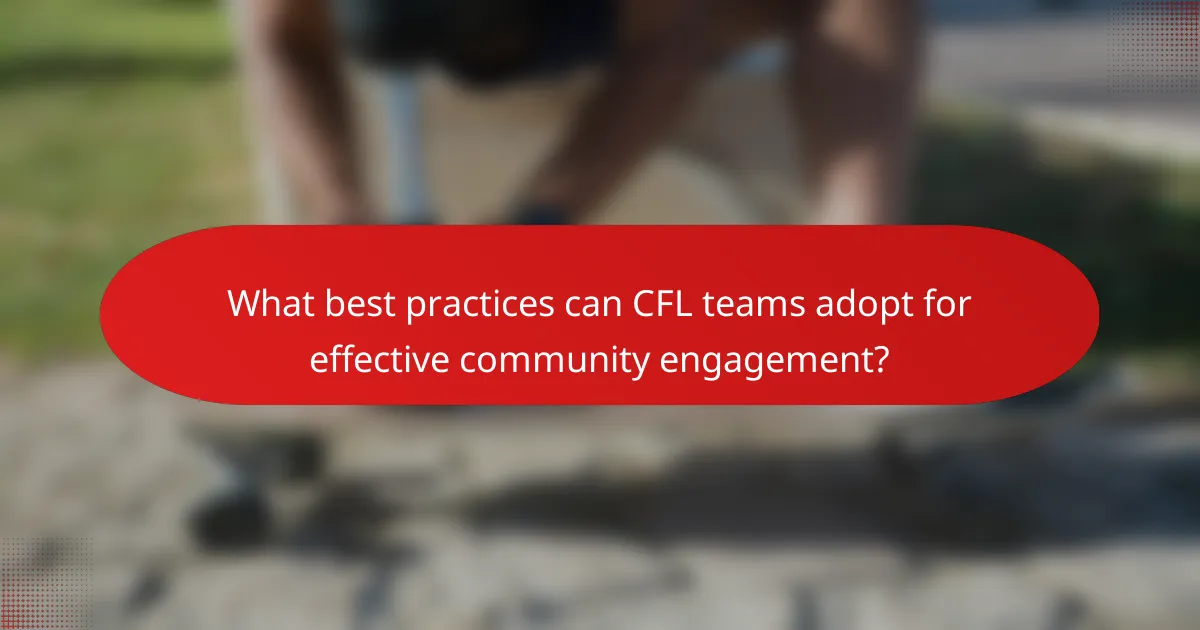
What best practices can CFL teams adopt for effective community engagement?
CFL teams can adopt several best practices for effective community engagement. Building partnerships with local organizations fosters trust and collaboration. Hosting community events allows fans to interact with players and staff, enhancing loyalty. Utilizing social media platforms ensures consistent communication and outreach. Implementing feedback mechanisms enables teams to adapt initiatives based on community needs. Lastly, promoting youth programs encourages sports participation and strengthens community ties.
How can teams leverage social media for community outreach?
Teams can leverage social media for community outreach by engaging directly with fans and promoting local initiatives. They can share updates on community events, highlight partnerships with local organizations, and encourage fan participation through interactive content. For example, the Canadian Football League teams often run campaigns that showcase local heroes and community leaders, fostering a sense of belonging. Additionally, they can utilize targeted advertising to reach specific demographics, enhancing their outreach effectiveness. Engaging content can improve team visibility and strengthen community ties.
What strategies enhance collaboration with local organizations and schools?
Collaborating with local organizations and schools enhances community engagement for Canadian Football League teams. Effective strategies include establishing partnerships, hosting joint events, and providing educational programs.
1. Build partnerships with local organizations to create shared goals.
2. Organize community events that encourage participation from schools and families.
3. Implement educational outreach programs that promote sportsmanship and teamwork.
4. Leverage social media to highlight collaborative initiatives and successes.
5. Offer internships or volunteer opportunities that involve local youth.
6. Engage in community service projects that address local needs.
What common mistakes should CFL teams avoid in their community initiatives?
CFL teams should avoid common mistakes like lack of community involvement, insufficient communication, and failure to measure impact. Engaging with local stakeholders is essential for successful initiatives. Teams must prioritize transparency and adapt strategies based on community feedback. A clear evaluation process helps identify effective practices and areas for improvement.
